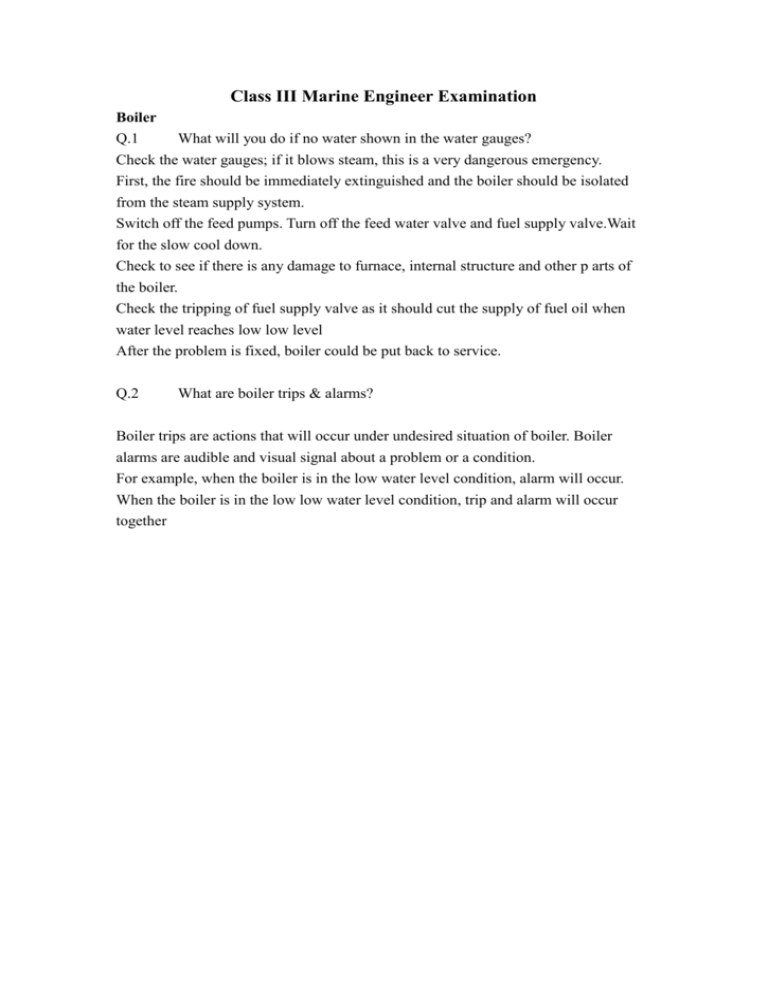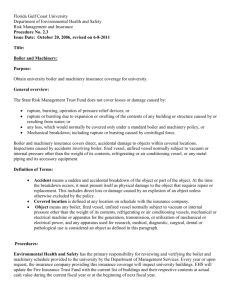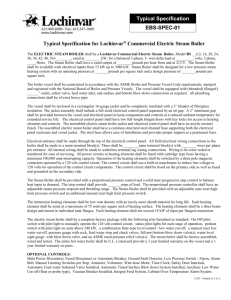Question and Answer 1
advertisement

Class III Marine Engineer Examination Boiler Q.1 What will you do if no water shown in the water gauges? Check the water gauges; if it blows steam, this is a very dangerous emergency. First, the fire should be immediately extinguished and the boiler should be isolated from the steam supply system. Switch off the feed pumps. Turn off the feed water valve and fuel supply valve.Wait for the slow cool down. Check to see if there is any damage to furnace, internal structure and other p arts of the boiler. Check the tripping of fuel supply valve as it should cut the supply of fuel oil when water level reaches low low level After the problem is fixed, boiler could be put back to service. Q.2 What are boiler trips & alarms? Boiler trips are actions that will occur under undesired situation of boiler. Boiler alarms are audible and visual signal about a problem or a condition. For example, when the boiler is in the low water level condition, alarm will occur. When the boiler is in the low low water level condition, trip and alarm will occur together Q.3 How to start up the boiler? First check the safety valves, air vent, manhole cover, steam valve, feed water pump, thermometer pressure gauge and water level gauge are in good condition. If all are ok, open the air vent. Then check the fuel oil system and circulate the fuel oil with heater to warm it to the required temperature and viscosity. Then run the force draft blower to purge the combustion area of any explosive gas accumulation. Put the flame spill in low position and open the fuel valve to fuel spray nozzle. Then press the ignition switches. If the fuel fails to ignite, close the fuel valve and repeat the procedure. To prevent thermal stress, the temperature should be raised slowly. Also, in order to let the air to release from the system, the air vent should be kept opened. When the pressure builds up, one should close the air vent and turn the flame spill to high position. Once the service pressure is reached, the steam valve should be opened slowly. If necessary, open the steam valve to oil tank carefully in order to prevent water hammering. Q.4 How to trip the boiler? Low low water level, high steam pressure and flame failure will also trip out the burner. Q.5 What is boiler blow down & why is it needed? Blow down of the boiler is done to remove scum and bottom deposits. This means that blow down is done either for scum or for bottom blow down. The reasons for boiler blow down are: 1. To remove the precipitates formed as a result of chemical addition to the boiler water. 2. In case of pollution from sea water, regular blow down is necessary to low the chloride level. 3. To remove solid particles, dirt, foam or oil molecules from the boiler water. This is mainly done by scum valve and the procedure is known as “scumming.” 4. To remove excess water in case of emergency. chroide Q.6 What is boiler water treatment & why is it needed? On pacific Java, the chemicals MULTI-PLUS and OXYTREAT are newly employed. MULTI-PLUS is for adding phosphate and alkalinity to minimize scale-formation, corrosion and sludge accumulation, while OXYTREAT is for adding tannin to remove oxygen in the system. By blowing down the boiler, the precipitates can be removed. Liquid treate: precipitates, alkanity Condensate: Ph Treatment is needed because forming of scale and corrosion would reduce efficiency and damage the boiler. Scale would thermally insulate the heating surface, so rise the metal temperature and the exit gas temperature. Corrosion would thinner the metal, or even made holes on tubes or surfaces, so as to endanger the boiler structure. Q.7 How to blow boiler water gauge glass? Check for the leak of the cocks. First close team and water cocks, open the drain, nothing should blow out if steam and water cocks are not leaking. In order to check the water cock connection to the boiler is clear, open and close the water cock to see if water blow out. In order to check the steam cock connection to the boiler is clear, open and close the steam cock to see if steam blow out. Close the drain. Open the water cock. Water should then gradually rise up to the top of the gauge glass. Then open the steam cock and the water in the glass should fall to the level of the water in the boiler. Q.8 Describe how to manual ignite the boiler? First check the boiler pressure and temperature are in normal condition under heating from the economizer. Circulate the boiler fuel through the heater to ensure suitable temperature and viscosity is reached. Check for the pressure of the circulated fuel. Then switch the control of the boiler into manual. Then start the forced draught fan and pass the air through the furnace for several 5-15 minutes to purge it of any exhaust gas or oil vapors. Then manually adjust the air input into the lighting up mode, open the fuel valve, press the ignition button, then press the fuel injection button and then leave the ignition power of the boiler. Then adjust control to normal service so that the air input and other parameter could be put into normal service. Check to see if the flame is steady. Q.9 What are the reasons caused low low water level? Low low water level may be caused by many reasons: 1. Blow down valve is accidentally opened 2. Feed water system- feed tank is empty, feed pump failure, automation control failure or other isolation from the feed system 3. Serious leakage on the water contacting area Q.10 What is boiler carry over (priming)? It is a harmful condition in which water is carried over from the boiler to the steam space. Cause of it may be contamination of boiler water by excess of salts or oil. Foaming occur because of them. Also, too high of the water level, excessive boiler loads, and sudden load changes could also lead to this problem. If it really happens, perform the water test and check the result, check to see any contamination for the water treatment equipment, chemical and the procedure. Check the steam loading, check the operator to see if he have made any sudden load changes before, etc.. Q.11 What is cross-blow? Cross blow is blowing the steam through the steam terminal cock and steam pipe, to the water cock, through the glass column to the drain, and also, blow the water through the water terminal cock and water pipe, to the steam cock, through the glass column to the drain. Open steam terminal cock, water cock and the drain, close other cocks, the steam terminal cock, steam pipe and the column are clear. Then close back and open water terminal cock, steam cock and drain, close other cocks, the water terminal cock and water pipe are clear. Q.12 Sketch the boiler inters structure & explains the difference between fire tube boiler & water tube boiler. Main Engine Q.13 What are the causes of crankcase explosion, 1st & 2nd explosion? For the first explosion, usually a hot spot could be possibly created in the crankcase. If the hot spot comes in contact with the lubricating oil, vaporization takes place. The vapour then circulates to a cooler place and condenses into white oil mist. The white oil mist would accumulate to create a higher concentration of the mist, and upon the explosive limit is reached, the crankcase explosion occur. The primary (first) explosion produces a shock wave which propagates inside the crankcase and it has a breaking effect to reduce the size of oil droplets, producing more fuel for ignition. The pressure is followed with a low pressure area which tries to suck more air from outside. If there is leak from relief valve, the stuffing box and crank case vent, a good environment with more few and air would be present. Usually the crankcase door may be rutureThe hot spot then ignite the flame and cause a very serve damage in the engine room. Q.14 What the causes are of scavenge fire? The cause of scavenge fire is blow-by of combustion product between liner and piston into the scavenge air spaces. This fouling will be greater if soot is produced because of incomplete combustion of the fuel injected. There are some causes of blow-by of combustion product, they are Worn, sticking or broken piston rings, Lubricating quills on liner are not working, Damage to the running surface of liner, The symptoms includes surging of turbocharger, rises of scavenge air temperature and exhaust temperature. This problem could be prevented by careful maintenance, which includes draining the scavenge cock, regular inspections and cleaning of scavenge spaces Detail refer to Marine Engineering Series – Diesel Engines A.J. Wharton Q.15 Compares the 2-stroke & 4-stroke engine advantages & disadvantages. For a 2-stroke engine, 1 stroke is for compression of gas and explosion, another stroke is for the exhaust gas to leave and the fuel-air mixture to be inserted into the cylinder. For a 4-stroke engine, there is 1 stroke for compression and then explode, 1 stroke for return, 1 stroke for pushing exhaust gas to leave, and the last 1 for the air and fuel to be inserted into the cylinder. The advantages of 2-stroke engine includes higher power to weight ratio and less moving parts such as exhaust valve, however, there may be problem of fuel-air mixture escaped with exhaust gas as there is relatively shorter time for scavenging to take place. The advantage of 4-stroke engine includes less chance for the fuel-air mixture escaped, but there is a problem of low power to weight ratio. Q.16 What is A/E scraper ring function? / Why the lube oil levels of main engine sump tank suddenly drop down rapidly? Oil scraper ring is on the piston that scrapes the excess oil off the liner wall on the down stroke of the piston. This is done to remove excess oil from combustion chamber to enhance a uniform oil layer formation. The lube oil level drop may because of leakage from sump tank or burning of the lube oil. Q.17 What will occur if the main engine cylinder liner wear our? If the cylinder liner worn out, there may be a space occur between the piston ring and the liner, thus, blow-by of combustion gas may occur. Also, lube oil from the crankcase may be passed into the combustion chamber. The wear may increase the friction on itself with the rings. The friction increase the temperature at that point and may cause hot spot. In addition, as the wear may increase the chance of crack formation, which leads to damage to the liner. Detail refer to Marine Engineering Series – Diesel Engines A.J. Wharton Q.18 What is turbo-charger surging? The blower rotates and releases air at a certain angle to the diffuser vane. The angle of the diffuser vanes are set to receive at that angle. If there is change of angle of the air due to drop in speed, a turbulence created and pressure is exerted which causes surging to take place. Causes of this phenomenon could be excess dirt clog onto the air filter, air cooler, turbine, compressor, or in the economizer. Therefore, careful cleaning of these parts in the system could prevent the turbocharger from surging. Also, bad weather could cause the turbocharger to surge. In bad weather, if the ship is pitching, the load of main engine load and velocity may vary and cause the exhaust gas vary. When the engine rpm is reduced suddenly, less amount of exhaust gas will be produced, which means less energy is supplied to the turbine, so the rpm of it will drop. However, due to inertia, the rpm would take some time to slow down and during this period, the compressor continues to deliver air the build up the pressure in the scavenge space. When the turbocharger slowed down, the air delivery pressure in the compressor is reduced and it is lower than the pressure in the scavenge space, so the air flow back, and the turbocharger again surge. Generator Q.19 What is protective device for main switchboard? Circuit breaker is an auto shut down device which activates during abnormal situation such as overloading and short circuit. It opens the supply circuit from main switchboard to isolate the consumer in question. Over current protection, which in case of overloading of the distribution system, removal of power supplies to non essential services on a preferential basis is done together with the preferential trips. The under voltage protection, (which prevent closure of the breaker by mistake or prevent the generator that is coming on load during parallel operation) and reverse power protection (which will release the breaker and prevent motring of alternator if a reversal of power occurs) Fuses are used for short circuit protection. If the current passing the fuse exceed the safe value, the fuse material melts and isolate the system from the main switchboard. Q.20 How to synchronize? First inform bridge and then check all the system in the engine side of the generator are normal. Then start the engine and check again the parameters and running situation immediately. Bring the generator to be synchronized to the desired parameters, then observe the synchroscope. The needle is moving clockwise, which means the frequency of the incoming machine is running faster than the bus bar. When the needle point at 11 oclock position, which means the machine is nearly in phase with the bus, at this moment, we could close the breaker. Safety Q.21 What will you do in case boiler room & purifier room fire? If there is a fire, I would first close the door and press the fire alarm to inform captain and chief engineer.. If it is a small fire, I will consider to use a suitable fire extinguisher nearby, but if the fire is large and there is no suitable fire extinguish, I would go to master station for further notice. Q.22 Describe the enclosed space entering procedure. First inform seniors and captain the necessarity of the entry, after getting their approve, I would start prepare the permit. First, if necessary, isolate any related pumps and valves, then make sufficient ventilation to the space. Then calibrate the gas testing device and test the gas to see if it is ok for supporting human live. Place the resuscitation and rescue equipment such as rescue lines, BA set and EEBD, outside the entrance. Arrange a qualified person to stand by at the entrance at all times with radio keeping contact with the man inside. Other Q.23 Briefly describe bilge system & how the oily separator operates. The bilge system consists of tanks, piping directed form tanks to OWS or shore facility connection, pumps and a set of valves controlling the inlet and outlet when operating the pump. In operation, the bilge from the tanks, which is relatively less oil is pumped to the OWS, passing through the 15ppm alarm and then overboard. The OWS operated in 2 stage and 1 filter in the middle of the stage. Working principles are by using Stokes’ settling (about the buoyant force) and coalescing effect (about the merging of small droplets). It is first filled with sea water, then the bilge is pumped to the stage 1, through the filter to the stage 2. There are coalescer inside stage 1 and 2. A 15ppm monitor is mounted before the overboard piping. It is used to bypass the output liquid when the fluid is over 15ppm limit. Q.24 Describe the oily record boiler purposes & the content of it. Oily record book is a requirement of MARPOL Annex I and it is used to record oil related activities to prevent and provide record for the oil related accident. The content include ballasting or cleaning of oil fuel tanks, discharge from fuel tanks, collection and disposal of oil residues, disposal of bilge, condition of filtering equipment, accidental ot other exceptional discharges of oil, bunkering and remarks. Q.25 What is 15ppm? Ppm is part per million, which means 1 kg material contains 1 mg other material, 15ppm is the maximum legal discharge value of the oily water separator. Q.26 What are the causes of the pump vibration? Mislining of the pump and motor, wear out of bearing, damaged impeller, undesired viscosity of the liquid. Q.27 What are the different between purifier & clarifier? A centrifuge is arranged to separate 2 liquids is called purifier, while a centrifuge is arranged to separate impurities and small amounts of water from oil is called clarifier. Ship Stability Q.28 What is bilge keel? Bilge keel is a long fin of metal welded along the length of the ship. It is employed in pairs, one for each side. Bilge keels increase the hydrodynamic resistance when a vessel rolls, so limit the amount of roll. Q.29 What is free surface effect & how to prevent free surface effect at ship? It is an effect occurs when the liquid moves across the tank in the direction of heel, making the centre of gravity moves away from the centerline, reducing the righting lever and increasing the angle of heel. The movement of the centre of gravity has been caused by the transfer of a wedge of liquid across the tank, so the righting lever was reduced. While the righting lever is reduced, it is useful to assume the effect of free surface is to raise the centre of gravity, so reducing the metacentric height of gravity. In a design point of view, the tanks with a longitudinal centerline division can reduce the free surface effect. Also, in practical view, pressing up tight tanks can prevent the liquid from moving across inside tanks.





